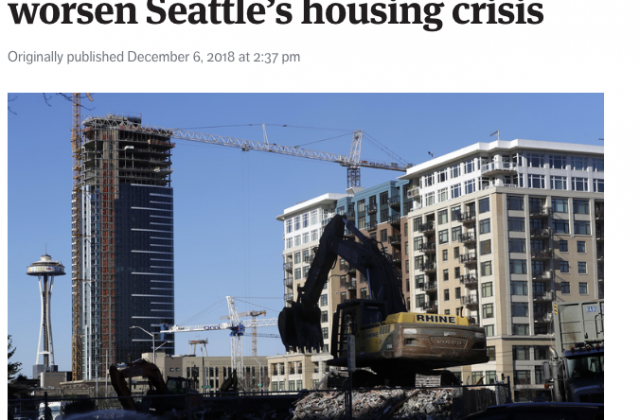The Problem With MHA: Seattle For Growth in the Seattle Times
On Friday the Seattle Times printed an editorial I wrote about the problems with Seattle Mandatory Housing Affordability (MHA) program, their version of Mandatory Inclusionary Zoning (MIZ). The program cleared a big hurdle before the Thanksgiving holiday when the Hearing Examiner ruled against neighborhood groups opposed to the upzones that are part of MHA. The editorial covers the same ground I’ve been going over for three years, saying MHA will make housing projects infeasible, and when they work it will be because prices have to go up to pay for the fees. Finally, the program is plainly illegal. What’s important about the editorial is the venue. It’s been difficult if not impossible to get the truth out about the fact that MHA doesn’t benefit all developers.
But there are big problems with MHA.
First, there were 10 signers of the grand bargain but only one large developer, Vulcan, signed for developers. There are hundreds of builders and developers in Seattle who were not at that table. There were three nonprofit developers, however, and the fees negotiated for extra capacity were favorable to projects in downtown and South Lake Union, not projects anywhere else.
I don’t think this one editorial will suddenly clear the heads of City Councilmembers and staff who have stubbornly ignored the numbers and facts about MHA. But at least its a prominent place to make it clear that developers didn’t demand more density. In fact, the whole program is being imposed on the housing economy with no involvement from the people that build housing.
As I’ve said before, we have been the victim of our own success in a way. Over the years the word “density” was one strongly associated with me and my message. It’s true that I said things like “density is good all by itself” and “density is people.”
What story or slogan could provide a strong enough theme to counter the NIMBY theme of a lone person defending their castle against greedy developers? That slogan, I think, just might be something like, “Density is People.”
My point was that it was that density was about people, more people in places they want to be. The only way to make that happen is bigger buildings on the same land where there are smaller buildings. Now, the MHA program has coopted this idea, throwing a bone to the dogs of housing demand. “You want density?” they are saying, “Well, here ya go! Now pay up!”
But incremental increases in Floor Area Ratio (FAR), a way of measuring density, doesn’t accomplish what many of us really want when we use the word “density.” And it really doesn’t help that the additional square footage being allowed is coming with a big price tag. And people who don’t build or understand how housing is built or financed seem to think that the “modest upzones” are some kind of win.
Slogans are important. They help communicate complex issues in a simple, direct way. But we have to be smart enough not to buy into the slogan so completely that we forget the underlying complexity when making policy. What “more density” includes is political and cultural shift that recognizes that housing is fundamentally a good thing, not an impact that has to be mitigated. The MHA program assumes that housing is bad, that it is hurtful and destructive and the only way to ameliorate that is to tax it, punish builders, and then give money to “good” developers who build affordable housing.
So called, “urbanists” have completely missed this point and have been cheering on MHA as if it was a solution. The editorial at least gets on the record that most of the people who understand and know how housing works and who build and operate it don’t want costly increases in FAR, they want to build more housing. Those are very different things.


